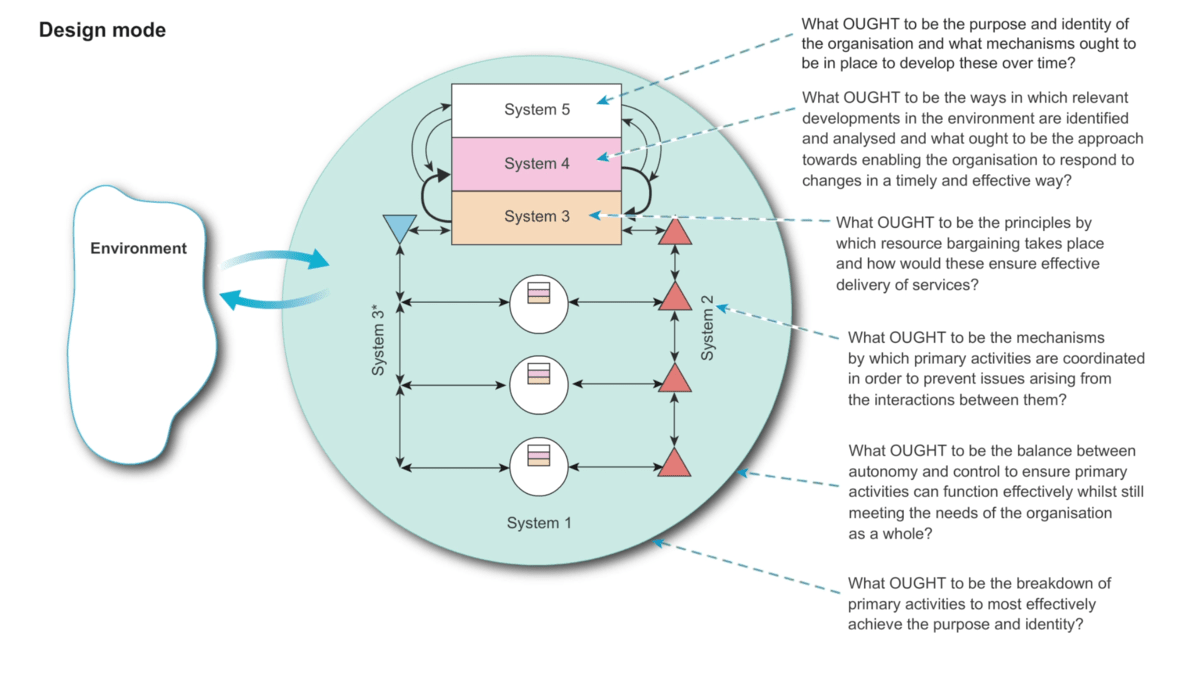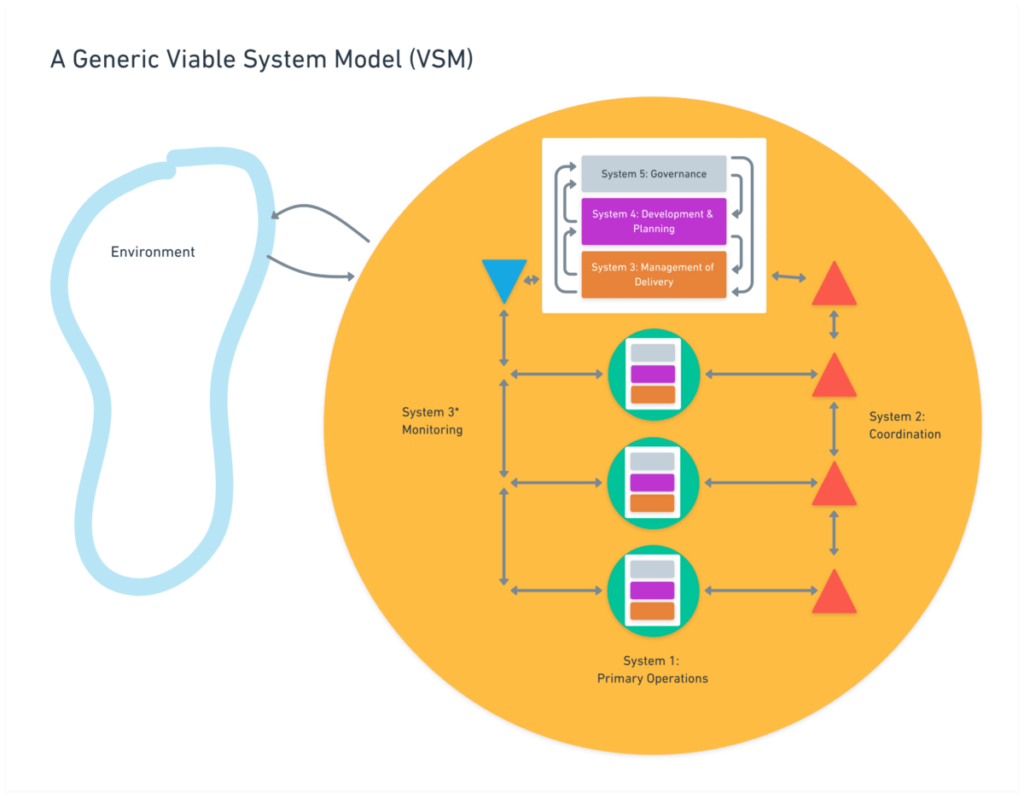TB871: Using the Viable System Model (VSM) in design mode for my system of interest
Note: this is a post reflecting on one of the modules of my MSc in Systems Thinking in Practice. You can see all of the related posts in this category.
The Viable System Model (VSM) can be used in both diagnostic and design modes. Up to this point, I’ve largely been using it in diagnostic mode to ascertain issues within my system of interest, which is ‘a system to promote lifelong learning’ in a library context.
In the diagram above, we can see how the VSM can be used in design mode. By asking questions about what ought to be the way each of the five systems are structured, we can design an effective approach. When applied to my system of interest, here’s how it could work.
System 1: Primary Activities
What ought to be the breakdown of primary activities to most effectively achieve the purpose and identity?
In a library promoting lifelong learning, primary activities could include:
- Workshops and seminars: Regular sessions on diverse topics such as digital literacies, job skills, and personal development.
- Reading programmes: Initiatives for different age groups to encourage reading and comprehension skills.
- Resource access: Providing access to books, journals, online databases, and learning materials.
- Community outreach: Partnering with local schools, businesses, and community centres to extend learning opportunities.
- Feedback mechanisms: Regular surveys and suggestion boxes to gather input from library users on their learning needs and preferences.
System 2: Coordination
What ought to be the mechanisms by which primary activities are coordinated in order to prevent issues arising from the interactions between them?
To manage seamless operation, coordination mechanisms could include:
- Scheduling software: Implementing an integrated scheduling system to avoid overlaps and manage resource allocation effectively.
- Communication channels: Establishing clear communication lines between staff and volunteers to ensure everyone is informed about upcoming events and activities.
- Regular meetings: Weekly or bi-weekly meetings to review ongoing programmes, address any issues, and plan future activities.
- Collaboration tools: Using digital tools like shared calendars and project management software to enhance teamwork among staff.
System 3: Management of Delivery
What ought to be the principles by which resource bargaining takes place and how would these ensure effective delivery of services?
Resource management principles could include:
- Budget allocation: Allocating funds based on priority areas such as educational resources, technology upgrades, and staff training.
- Partnerships: Forming strategic partnerships with educational institutions, tech companies, and local businesses to pool resources and expertise.
- Performance metrics: Establishing clear performance indicators to monitor the success of various programmes and adjust resource allocation accordingly.
- Transparent processes: Maintaining transparency in decision-making processes related to resource allocation and programme funding.
System 4: Development and Planning
What ought to be the ways in which relevant developments in the environment are identified and analysed and what ought to be the approach towards enabling the organisation to respond to changes in a timely and effective way?
Adapting to changes can be managed through:
- Environmental scanning: Regularly monitoring trends in education, technology, and community needs to stay ahead of changes.
- Advisory committees: Forming committees with representatives from different community sectors to provide insights and feedback.
- Pilot programmes: Testing new initiatives on a small scale before full implementation to gauge effectiveness and make necessary adjustments.
- Flexibility: Developing flexible strategic plans that can be quickly adjusted in response to emerging trends and feedback.
System 5: Identity and Purpose
What ought to be the purpose and identity of the organisation and what mechanisms ought to be in place to develop these over time?
The overarching purpose and identity of the library system could be defined as:
- Mission statement: “To empower individuals of all ages through accessible and comprehensive lifelong learning opportunities.”
- Core values: Inclusivity, accessibility, community engagement, and continuous improvement.
- Brand development: Creating a strong, recognisable brand that reflects the library’s commitment to lifelong learning.
- Stakeholder engagement: Regularly engaging with stakeholders, including library users, staff, and community leaders, to ensure the mission and values remain relevant and impactful.
- Continuous review: Periodically reviewing and updating the mission statement and core values to align with the evolving needs of the community.
As the module materials note, giving the example of The Open University itself, the way that you might design a system from scratch could be very different to the way the organisation looks now. This is because organisations change organically over time. However, using the VSM both in diagnostic and design mode can lead to some interesting insights as to what is going wrong, and what could be better.
References
- The Open University (2020) ‘3.4.2 Reflecting on diagnosis and design’, TB871 Block 3 Tools stream [Online]. Available at https://learn2.open.ac.uk/mod/oucontent/view.php?id=2261487§ion=5.2 (Accessed 5 July 2024).




